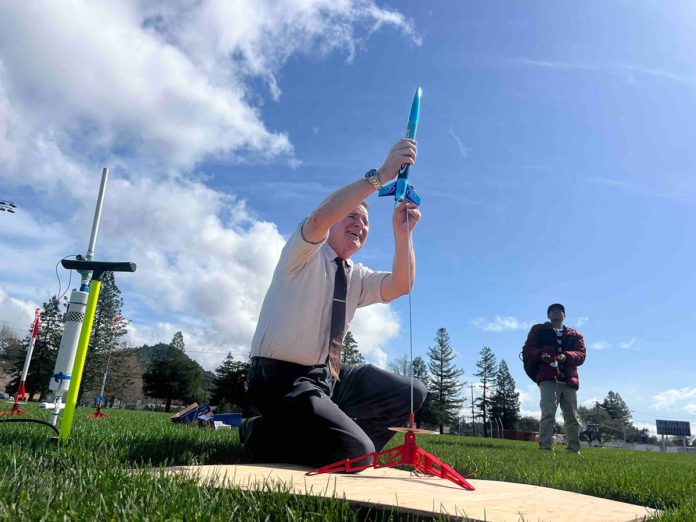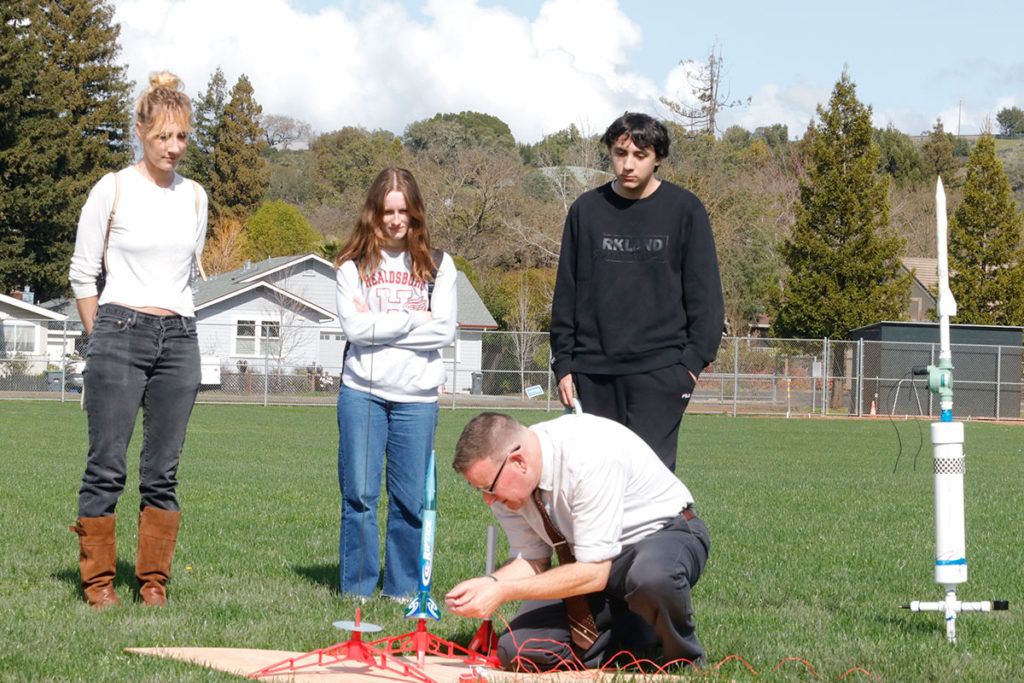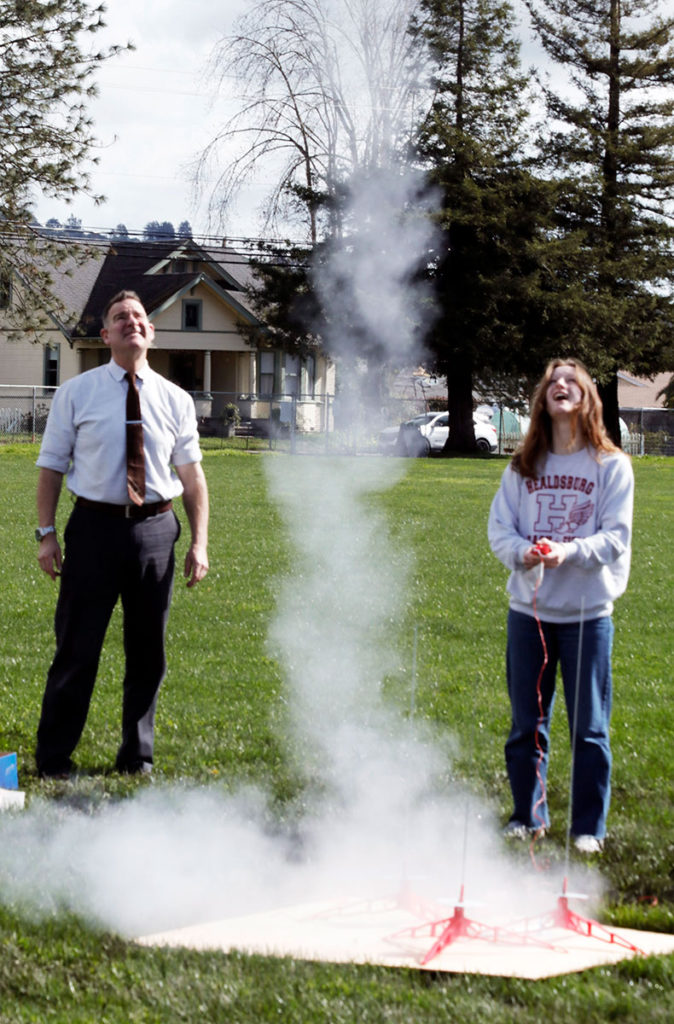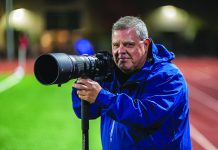
A six-year crusade to incorporate rocket science into the official school-day curriculum at Healdsburg High School, led by art teacher Linus Lancaster, culminated last Thursday with a rocket launch at lunchtime.
“Somebody grab the air compressor!” said Lancaster, a U.S. Navy veteran and aviation enthusiast who has been a fixture in the high school art department for a couple of decades now. His upside-down wall clock was steadily ticking its way into the half-hour lunch period.
Students from the school’s Art and STEAM clubs, plus some curious tagalongs, trudged over to the baseball field on the first clear, sunny day in a week. “I know it’s wet and squishy out here, but the rain is part of why we got permission to do this,” Lancaster told the kids.

Countdown
For years, Lancaster has been trying to get the go-ahead from the Healdsburg Unified School District and the Healdsburg Fire Department to incorporate “formal lessons on basic rocketry” into art, math and science classes at the high school—including “designing and building dry fuel model rockets” and launching them hundreds of feet into the air from the school’s baseball field.
In the meantime, the art teacher has run some after-school and weekend rocket workshops with support and funding from local organizations like the Healdsburg Center for the Arts and Corazón Healdsburg—but his dream has always been to work rocketry into the high school’s actual curriculum.
“When you ask to do something like this,” he said, “the first question is always: ‘Who else is doing it and what does it look like?’ Because institutions tend not to like to be trailblazers.”
So in late 2022, when Lancaster tracked down two public schools in Alabama and Philadelphia that had pulled the trigger on similar programs, he said it was a turning point in the conversation.
Superintendent Chris Vanden Heuvel said in an email to the Tribune: “We do have to look at all risks for these types of things, including student/staff safety and liabilities that may arise. After assessing these risks with our business office, we were able to approve this awesome opportunity for our students.”
Ready to Launch

Now, with written permission in hand from Healdsburg’s schools superintendent and fire marshal, Lancaster says around 200 students enrolled in art and math classes at Healdsburg High will start in immediately on the rocket lesson plan he wrote—beginning with safety education—then design and build, then launch in late March or early April.
He hopes the new program will “inspire other public school districts to follow suit.”
At the first-ever school-day rocket launch last week, students and teachers sent up some out-of-the-box models from the Estes rocket company “to get some excitement going,” in Lancaster’s words.
HHS junior Andrew Ambrosi said he received a message about it in one of his group chats with friends, and “came running over” because he “wanted to see a real rocket go off.” (He had to run back, too, when he realized he was missing his own fifth-period presentation.)
A few kids whipped out their phones to record a bright-blue, foot-and-a-half-long Estes “Riptide” rocket shooting around 250 feet into the airspace above the baseball field at University and Monte Vista avenues. Other students squealed and scattered. At the end, as the rocket deployed its own mini parachute and fluttered back down to Earth, there was applause.
The high school’s newest and youngest math teacher, 24-year-old HHS alum Matthew Lopez, also attended. Soon, his students will write equations for where they want their own rockets to land. “Our goal is to model the actual flight path,” Lopez said. “I’m always trying to find a way to do something that isn’t paper, pencil, calculator.” To that end, his math students also collaborated recently with Lancaster’s ceramics students on a sundial project.
Lesson Plan
The goal of the new rocket curriculum is to “motivate students to engage in creative, real world problem solving activities in the fields of art practice, math, physics, and engineering,” the lesson plan says, “whose results will have a tangible thrill factor with ripple effects into other disciplines.”
Another HHS junior, 17-year-old Joie Kozubal, said she was walking home from school one day when Lancaster waved her over to play with some rockets—and she was hooked.
“I’ve been wanting this,” Kozubal said at last week’s launch. “I’ve been asking for an engineering class since ninth grade. And now, finally, in my junior year—I’m so happy it’s now and not later.”
Kozubel got to flip the switch for one of the inaugural flights. “POWER!” she yelled. “So cool.”
Next, “the students are going to be doing an entirely custom build,” Lancaster said. “So they’re going to have to be following exact directions; they’re going to be cutting their own fins out of balsa wood; and they’re going to be doing some problem-solving in terms of the parachute.”
There’s a touch of international history mixed into the lesson plan, too. The students’ 9-inch pencil rockets will be modeled after “the first rocket that was built by the Japanese space agency in the 1950s,” Lancaster said. Students will even make their parachutes from silk, as the early rocketeers did.
The origins of Japan’s scrappy space agency, JAXA, are compelling, the art teacher said. “They started with nothing. NASA has all the money in the universe, and JAXA is just on this shoestring budget and they’re complaining that the roof of their building is leaking. To me, it’s just kind of charming that they’ve persevered through all of this. So they are our inspiration.”
On Thursday, March 7, weather willing, the scrappy rocket crew from HHS plans to send a few more ready-made Riptide rockets into the sky over town—launching a new transdisciplinary “art integration” movement at the local high school campus.







